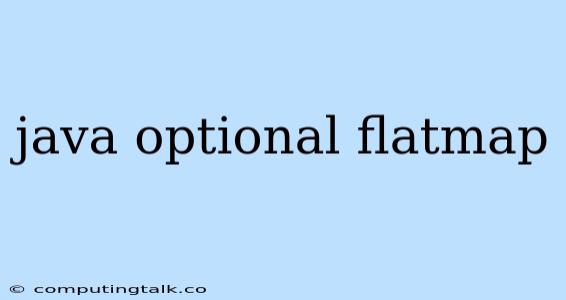Harnessing the Power of Java Optional and FlatMap
In the realm of Java programming, handling null values gracefully is paramount. The introduction of Optional in Java 8 marked a significant step forward in addressing this common issue. Coupled with the power of flatMap, Optional enables elegant and concise code for dealing with potential null scenarios.
Let's delve into the world of Optional and flatMap to understand how they work hand in hand to enhance the robustness and readability of our Java code.
What is Optional?
Optional is a container class that holds either a non-null value or represents the absence of a value. It effectively encapsulates the concept of "null" by providing a more explicit and type-safe way of handling its presence or absence.
Here's how Optional empowers us:
- Explicit Null Handling: Instead of relying on the implicit assumption of null,
Optionalforces us to acknowledge the possibility of a value not being present. - Improved Code Readability: Code using
Optionalbecomes more self-documenting, making it easier to understand whether a value is expected or might be absent. - Reduced NullPointerExceptions:
Optionalhelps prevent the dreadedNullPointerExceptionby providing methods likeisPresent()to check for the presence of a value before attempting to access it.
Introducing FlatMap: A Powerful Partner
flatMap is a method of the Optional class that allows us to perform transformations on the contained value while seamlessly handling potential nulls. It's like a "map" that works specifically with Optional objects, chaining operations together in a declarative way.
flatMap takes a function as an argument. This function should accept a non-null value of the contained type and return another Optional object. flatMap then unwraps the inner Optional and returns a new Optional containing the final result.
How FlatMap Works with Optional
Let's illustrate the magic of flatMap with a simple example. Imagine we have a list of users, each with an optional address. We want to extract the street name from the address of each user.
import java.util.Optional;
class User {
private String name;
private Optional address;
// Constructor, getters, and setters
}
class Address {
private String street;
private String city;
// Constructor, getters, and setters
}
public class FlatMapExample {
public static void main(String[] args) {
User user1 = new User("Alice", Optional.of(new Address("123 Main Street", "Anytown")));
User user2 = new User("Bob", Optional.empty());
// Extracting the street name using flatMap
Optional street1 = user1.getAddress().flatMap(address -> Optional.ofNullable(address.getStreet()));
Optional street2 = user2.getAddress().flatMap(address -> Optional.ofNullable(address.getStreet()));
System.out.println("Street for Alice: " + street1.orElse("N/A"));
System.out.println("Street for Bob: " + street2.orElse("N/A"));
}
}
In this example:
- We use
flatMapto extract the street name from theOptional<Address>of each user. - The function passed to
flatMaphandles the case where the address might be absent. Optional.ofNullablesafely handles the case whereaddress.getStreet()might return null.- The result is a new
Optional<String>containing the street name or an emptyOptionalif the address is missing.
Common Use Cases of Optional and FlatMap
Optional and flatMap become particularly valuable when dealing with complex data structures or chained operations involving potentially null values. Here are some common scenarios:
- Extracting Values from Nested Data: Handling nested JSON or XML structures where data might be optional at various levels.
- Performing Operations on Optional Collections: Iterating over collections of
Optionalobjects and manipulating the values they hold. - Chaining Multiple Transformations: Applying multiple operations on a value while ensuring each step handles potential nulls gracefully.
Benefits of Using Optional and FlatMap
- Improved Error Handling: By explicitly handling nulls, we prevent unexpected
NullPointerExceptions. - Enhanced Code Readability:
OptionalandflatMapprovide a clear and concise way to express potential null scenarios. - Reduced Code Complexity: We can avoid verbose null checks and conditional logic, making our code more maintainable.
Best Practices for Optional and FlatMap
- Favor
Optional.ofNullable: Always useOptional.ofNullablewhen creatingOptionalobjects to ensure that they are correctly initialized. - Use
flatMapfor Chained Operations: When performing transformations on values within anOptionalobject,flatMapis the ideal choice. - Avoid Nested Optionals: If you find yourself nesting
Optionalobjects deeply, consider refactoring your code to simplify it.
Conclusion
Optional and flatMap provide a powerful combination for handling potential nulls in a clean and concise manner. They promote robust code, reduce errors, and improve overall code readability. By embracing these features, we can create more reliable and maintainable Java applications.
